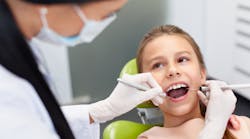So you think you need new dental equipment? Know the ROI before you sign on the dotted line
Shiny new dental equipment is exciting, but before dentists make those big purchases they're just positive they need, it's important to find out if the ROI will be worth the expense, and if patient care will actually improve.
Who wouldn’t prefer an office brimming with new technologies and equipment over one with outdated models? The answer may seem obvious, unless you’re a dentist who ‘s seen the price tag on a state-of-the-art dental office. A periapical x-ray unit, for example, retails for as much as $5,000. A top-of-the-line patient chair could set you back $9,000. Factor in the cost of the latest handpieces, sterilization systems, operating systems and all the other furniture, supplies, and equipment a dentist needs, and you could be looking at a total investment of $150,000 or more for an office upgrade. Keeping up with technology can be like keeping up with the Joneses—there will always something out there that is the latest and greatest, with equipment continually evolving.
While your heart might be telling you to focus on the amazing advances this equipment offers to today’s dentists, your brain might be slamming on the financial brakes, or at least telling you to make sure the investment will yield an acceptable return.
Consider a dentist I worked with who purchased a cone beam not long ago. He believed that having the most sophisticated diagnostic imaging technology would open the door to many possibilities and potentially transform his practice. He reasoned that equipment could deliver a great customer experience and would therefore quickly pay for itself.
However, after arranging a term loan for nearly $150,000, he learned there were a few complications. He planned on dedicating extra space to accommodate the large equipment, but the renovation required cost overruns. The unintended consequences made the cost of owning this equipment significantly higher than planned. Meanwhile the equipment evolved significantly in just two years to become less expensive and more compact.
Hindsight being 20/20, this dentist can now look back and see how this equipment purchase got off track. The good news is that such an outcome can be avoided. There are a number of important factors you should consider before making an equipment purchase decision.
1. Is the investment worth it?
Some purchases are no-brainers. If the cost to repair existing equipment approaches that of total replacement, for example, buying new is common sense. Purchasing essential equipment that will pay for itself in a reasonable time is also common sense.
The decision becomes less clear-cut for equipment that is not central to your practice and may not deliver the ROI needed to justify purchase. For example, consider the special equipment needed for cosmetic dentistry. It could take longer than its expected life to deliver a return, especially if the demographic you serve cannot afford dental esthetics.
2. Is it possible to calculate your ROI before making a purchase?
You can and certainly should estimate ROI before you sign on the dotted line. To get an idea of what ROI might be, divide the increase you expect in profit by the dollar investment you’ll make to acquire the equipment. For example, your dental practice may be able to add $5,000 in new revenue a year (raising profit by the same amount) by spending $25,000 on a new piece of equipment. This yields an ROI of $5,000 divided by $25,000, or 20%. If this figure is higher than the interest you would pay on an equipment loan, and no better investment opportunities exist for those funds, it may make sense to purchase the equipment. It’s always a good idea to sit down with a financial adviser and review your options.
3. Are there ancillary costs that must be factored into your ROI?
In many cases, yes. As the dentist who purchased the cone beam learned, it is critical to do space planning before you purchase. Even if you have all the physical space you need, you might need an electrician or other professionals to adapt the space for your new purchase.
You also might learn that the equipment will add significantly to your monthly electric bill. In other words, take an inventory of the costs associated with the purchase, whether they’re one-time or ongoing, and factor them into your ROI equation.
There is also an intangible item to consider when assessing ROI, and that is your patients’ expectations. In many competitive markets, dental practices are expected to be state of the art. Dentists who don’t offer digital x-rays, new dental chairs, and all the latest bells and whistles may find themselves losing patients to more up-to-date practitioners. In other markets, most dentists may still use film to take x-rays, and patients may be perfectly satisfied. In other words, ROI is not a one-size-fits-all. A good investment for one dental practice could spell financial trouble for another. It’s important to keep your desire for the latest “dental toy” in check and focus on investments with the potential for the greatest returns.
4. How long will it take for the equipment to begin paying for itself?
When you’re figuring the ROI on a potential purchase, remember that most equipment does not begin generating revenue on day one. In fact, it can take months to build the business and collect the patient payments needed to begin payback.
Understanding this lag time is important when working with a lender to create a payment schedule. The dentist who purchased the cone beam, for example, made interest-only payments the first three months for this very reason. A lender that is accustomed to working with dentists is more likely to work with you and design a payment plan that factors in low first-year revenues and helps keep your cash flow strong.
5. Is it better to lease or purchase?
This depends. There are advantages to each. For example, an equipment company’s leasing business may allow a dentist to trade in a piece of equipment for a new model before the lease ends. Be sure to ask about other costs and fees.
If you’re interested in owning equipment outright, a dentist-friendly bank may offer a better interest rate than an equipment company. A bank may also offer payment options not available in equipment leases, such as interest-only payments at the onset of the loan. Also, if you have visions of long loan applications at the bank, you might be pleasantly surprised when dealing with a dentist-friendly bank.
6. What if I must act quickly?
Dentists often plan expansions or exam room upgrades years in advance. But sometimes, a need or an opportunity presents itself when least expected. That’s why virtually every dentist will benefit by getting preapproved for financing before starting an equipment search. If you haven’t been preapproved, you might look for financing options designed specifically for dental practices. Commerce Bank, for example, offers a Fast Track Dental Loan Program that makes it easy for dentists to move quickly when necessary. The process results in a streamlined method of accessing credit quickly.
The bottom line? Expanding or upgrading your dental office is an expensive proposition, and it might be just the thing you need to grow your practice. A key component to building a successful practice is selection and timing of expenditures, combined with the financing solution that will enable you to meet your business goals.
With over 12 years of business lending experience in the Colorado market of Commerce Bank, Paul Jerez’s primary focus is strengthening relationships in the dental market with current customers and prospective clients. Paul provides a holistic approach in meeting the needs of businesses, including loans, lines of credit, deposit solutions, and money management. Paul understands that dentists are passionate about helping patients, so his goal is to make that mission as effortless as possible.






